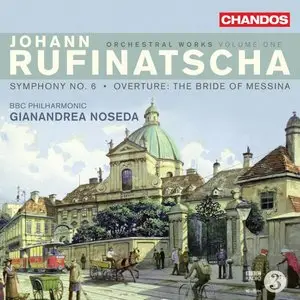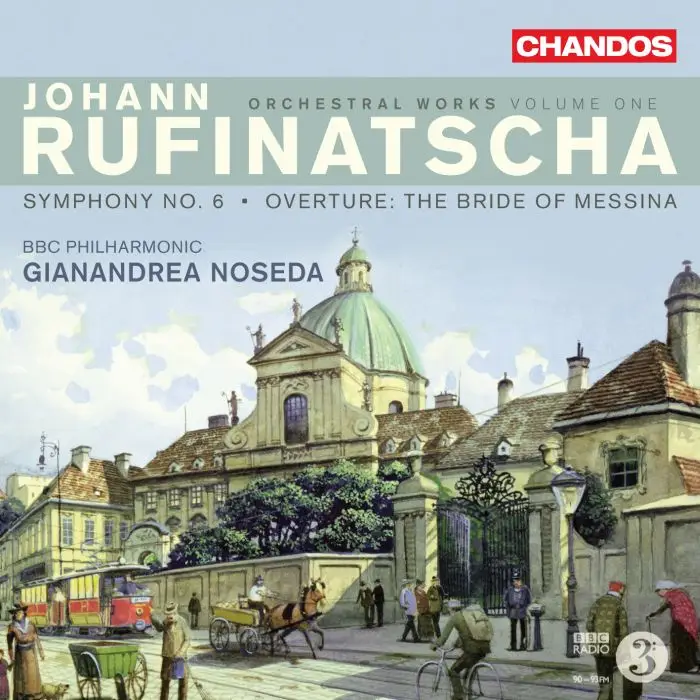Noseda, BBC Philharmonic - Johann Rufinatscha: Orchestral Works, Vol. 1 (2011)
EAC Rip | Flac (Tracks + cue + log) | 268 MB | MP3 320Kbps CBR | 170 MB | 1 CD | Full Scans
Genre: Classical | Label: Chandos | Catalog Number: 10665
EAC Rip | Flac (Tracks + cue + log) | 268 MB | MP3 320Kbps CBR | 170 MB | 1 CD | Full Scans
Genre: Classical | Label: Chandos | Catalog Number: 10665
This is Volume 1 of a planned series of three, bringing to life the rarely heard but colourful music of the Austrian composer Johann Rufinatscha. The works presented here have never been recorded before, and are performed by the BBC Philharmonic Orchestra under Gianandrea Noseda, an exclusive Chandos artist – a partnership of long standing, noted for the precision and fullness of their sound as well as for the strength of their musical interpretations.
Although very little is known of Johann Rufinatscha today, in his time he held an established place in Vienna’s highest musical circles and enjoyed considerable acclaim for his orchestral, chamber, and piano works, some even predicted for him a stellar future. He was a respected teacher and a great friend of Brahms who was not a man to suffer musical fools gladly. The music of Rufinatscha, represented here by two later works, is rich and dramatic, with expressively charged melodies running throughout. His orchestral works are ambitious in scale, strong in content, and suggest a confident, refreshingly unfettered musical mind. Still, his output tailed off strikingly after he completed his Sixth Symphony (recorded here), and he increasingly devoted his energies to teaching, especially piano and harmony, in which he exerted a significant influence – pupils included the pianist Julius Epstein and the pianist-composer Ignaz Brüll.
We do not know what prompted Rufinatscha to write his Overture The Bride of Messina, but at fourteen minutes it would not have been the prospect of a theatrical performance. The overture is far too large – in more senses than one – to function successfully as a curtain raiser. It’s a substantial and very powerful piece that sums up the storyline of Friedrich Schiller’s play Die Braut von Messina perfectly. The richly contrasted opening sets the overall tragic mood of the opera, while the tellingly tender lyrical theme, set on violas and cellos, that follows is symbolic of Schiller’s character Beatrice who is loved by two brothers, neither of whom is aware that she is in fact their sister. The conflict that builds between the brothers throughout is portrayed through characteristically fine trumpet writing. Symphony No. 6 is an accomplished and richly contrasted work that bears no sign of a composer in decline or about to face it. Nonetheless, it is one of the very last works that Rufinatscha composed before dedicating his time solely to teaching. Following an imposing, Schubert-inspired opening tutti, a bracing Allegro con fuoco takes centre stage. Then follows a melodic and infectious Scherzo, and a sombre Largo coloured by clarinets, bassoons, violas, and cellos, before the finale builds to a resolute and rousing conclusion that only leaves us wondering: What happened to Johann Rufinatscha?
Composer: Johann Rufinatscha
Conductor: Gianandrea Noseda
Orchestra/Ensemble: BBC Philharmonic Orchestra
Reviews: Don’t bother looking up Johann Rufinatscha (1812–93) in Grove’ s, or in Baker’ s, MGG, or any other leading music dictionary or encyclopedia. He isn’t there. If there are any previous recordings of his music, I have been unable to locate them. However, this all-but-forgotten 19th-century composer has just been resurrected by Chandos in the first of what we may surmise—and hope—to be a series (this production is designated as Volume 1).
Stephen Johnson’s helpful liner notes inform us that Rufinatscha was born in the South Tyrolean town of Mals, today “known best as a spectacular skiing resort in the Italian Alps, yet its culture—especially its food, music, and language—remains as unmistakably Austrian as it would have been in Rufinatscha’s own time.” He studied in Innsbruck, then in Vienna, where he became part of Brahms’s musical circle, and established himself first as a composer and then as a teacher. Although he lived until 1893, he produced no more symphonies after the Sixth in the early 1860s, and nothing at all after 1880. What caused this decline in output from a composer whose music, on the basis of what we have here, was fine indeed? Johnson ponders the matter in his notes but comes to no firm conclusion, ending with the question, “What happened to Johann Rufinatscha?”
We would like to know, for both the symphony and the overture are well-written compositions full of stirring ideas that present a composer far greater than his reputation. In Johnson’s notes there are references to Beethoven, Brahms, Mendelssohn, and Bruckner, but to my ears the composer Rufinatscha most closely resembles is Schumann. Rufinatscha’s overture The Bride of Messina surges with the dark tragedy and feverish impulses of Schumann’s Manfred Overture. Stabbing syncopations, dramatic contrasts, and throbbing middle voices in the strings alternate with passages of sweeping, lyric beauty. Even at 14 minutes it does not overstay its welcome, and I daresay it is a better piece than Schumann’s own take on the fateful story, written in the same key of C Minor.
The symphony, too, has much to recommend it. At nearly an hour in length, it brings to mind Schubert’s “Great C-Major” Symphony as well as some of Bruckner’s creations, but, unlike these masters, Rufinatscha does not hold the attention quite as well. The 15-minute Scherzo is truly too long, despite some good ideas. However, the two best movements are very good indeed. The 13-minute Largo is bathed in a warm, romantic glow, sumptuously scored with a rich string sonority, while the rousing, festive finale, full of fanfares, and the driving forward motion brings to mind the analogous movements of Schumann’s Second and Third symphonies.
Gianandrea Noseda conducts the BBC Philharmonic with conviction and panache, the orchestra plays with characteristic British brilliance, and most listeners, I believe, are going to be eagerly looking forward to Volume 2 in the projected series.
Tracklisting:
The Bride of Messina - Overture [14:01]
Symphony No. 6 in D major
I. Largo - Adagio - Andante - Allegro con fuoco [19:31]
II. Scherzo. Allegro ma non troppo - Trio [14:22]
III. Largo [12:58]
IV. Allegro moderato - Allegro - Allegro moderato - Allegro vivace [9:45]
BBC Philharmonic
Gianandrea Noseda
Exact Audio Copy V1.0 beta 3 from 29. August 2011
EAC extraction logfile from 2. April 2015, 11:03
Johann Rufinatscha / Symphony 6
Used drive : ATAPI iHDS118 6 Adapter: 2 ID: 0
Read mode : Secure
Utilize accurate stream : Yes
Defeat audio cache : Yes
Make use of C2 pointers : No
Read offset correction : 6
Overread into Lead-In and Lead-Out : No
Fill up missing offset samples with silence : Yes
Delete leading and trailing silent blocks : No
Null samples used in CRC calculations : Yes
Used interface : Native Win32 interface for Win NT & 2000
Gap handling : Appended to previous track
Used output format : Internal WAV Routines
Sample format : 44.100 Hz; 16 Bit; Stereo
TOC of the extracted CD
Track | Start | Length | Start sector | End sector
––––––––––––––––––––––––––––-
1 | 0:00.00 | 14:10.63 | 0 | 63812
2 | 14:10.63 | 19:37.00 | 63813 | 152087
3 | 33:47.63 | 14:28.20 | 152088 | 217207
4 | 48:16.08 | 13:03.00 | 217208 | 275932
5 | 61:19.08 | 9:47.12 | 275933 | 319969
Track 1
Filename C:\Users\Wim Wummi\Documents\(01) Die Braut von Messina Ov..wav
Pre-gap length 0:00:02.00
Peak level 71.2 %
Extraction speed 7.1 X
Track quality 100.0 %
Test CRC 4CB54301
Copy CRC 4CB54301
Cannot be verified as accurate (confidence 4) [F6B6E870], AccurateRip returned [1DA85C8B] (AR v2)
Copy OK
Track 2
Filename C:\Users\Wim Wummi\Documents\(02) Symphony 6 - I. Largo - Allegro.wav
Pre-gap length 0:00:08.77
Peak level 97.6 %
Extraction speed 9.2 X
Track quality 100.0 %
Test CRC 1B1B9EB8
Copy CRC 1B1B9EB8
Cannot be verified as accurate (confidence 4) [E734908F], AccurateRip returned [4207F42E] (AR v2)
Copy OK
Track 3
Filename C:\Users\Wim Wummi\Documents\(03) II. Scherzo.wav
Pre-gap length 0:00:05.77
Peak level 96.5 %
Extraction speed 10.7 X
Track quality 100.0 %
Test CRC E73ED26C
Copy CRC E73ED26C
Cannot be verified as accurate (confidence 4) [DF6FBE7F], AccurateRip returned [EF6271C8] (AR v2)
Copy OK
Track 4
Filename C:\Users\Wim Wummi\Documents\(04) III. Largo.wav
Pre-gap length 0:00:06.04
Peak level 61.7 %
Extraction speed 11.7 X
Track quality 100.0 %
Test CRC 8D94EF62
Copy CRC 8D94EF62
Cannot be verified as accurate (confidence 4) [63E4ADA2], AccurateRip returned [1BC3A869] (AR v2)
Copy OK
Track 5
Filename C:\Users\Wim Wummi\Documents\(05) IV. Allegro Moderato.wav
Pre-gap length 0:00:04.77
Peak level 99.3 %
Extraction speed 12.0 X
Track quality 100.0 %
Test CRC AEBDFE3E
Copy CRC AEBDFE3E
Cannot be verified as accurate (confidence 4) [1B91F8F8], AccurateRip returned [CF96AF87] (AR v2)
Copy OK
No tracks could be verified as accurate
You may have a different pressing from the one(s) in the database
No errors occurred
End of status report
==== Log checksum B49910A12E23DE6B632EEDB6665B2C9E5E0C764E6649723C95287CD52CE439F2 ====
EAC extraction logfile from 2. April 2015, 11:03
Johann Rufinatscha / Symphony 6
Used drive : ATAPI iHDS118 6 Adapter: 2 ID: 0
Read mode : Secure
Utilize accurate stream : Yes
Defeat audio cache : Yes
Make use of C2 pointers : No
Read offset correction : 6
Overread into Lead-In and Lead-Out : No
Fill up missing offset samples with silence : Yes
Delete leading and trailing silent blocks : No
Null samples used in CRC calculations : Yes
Used interface : Native Win32 interface for Win NT & 2000
Gap handling : Appended to previous track
Used output format : Internal WAV Routines
Sample format : 44.100 Hz; 16 Bit; Stereo
TOC of the extracted CD
Track | Start | Length | Start sector | End sector
––––––––––––––––––––––––––––-
1 | 0:00.00 | 14:10.63 | 0 | 63812
2 | 14:10.63 | 19:37.00 | 63813 | 152087
3 | 33:47.63 | 14:28.20 | 152088 | 217207
4 | 48:16.08 | 13:03.00 | 217208 | 275932
5 | 61:19.08 | 9:47.12 | 275933 | 319969
Track 1
Filename C:\Users\Wim Wummi\Documents\(01) Die Braut von Messina Ov..wav
Pre-gap length 0:00:02.00
Peak level 71.2 %
Extraction speed 7.1 X
Track quality 100.0 %
Test CRC 4CB54301
Copy CRC 4CB54301
Cannot be verified as accurate (confidence 4) [F6B6E870], AccurateRip returned [1DA85C8B] (AR v2)
Copy OK
Track 2
Filename C:\Users\Wim Wummi\Documents\(02) Symphony 6 - I. Largo - Allegro.wav
Pre-gap length 0:00:08.77
Peak level 97.6 %
Extraction speed 9.2 X
Track quality 100.0 %
Test CRC 1B1B9EB8
Copy CRC 1B1B9EB8
Cannot be verified as accurate (confidence 4) [E734908F], AccurateRip returned [4207F42E] (AR v2)
Copy OK
Track 3
Filename C:\Users\Wim Wummi\Documents\(03) II. Scherzo.wav
Pre-gap length 0:00:05.77
Peak level 96.5 %
Extraction speed 10.7 X
Track quality 100.0 %
Test CRC E73ED26C
Copy CRC E73ED26C
Cannot be verified as accurate (confidence 4) [DF6FBE7F], AccurateRip returned [EF6271C8] (AR v2)
Copy OK
Track 4
Filename C:\Users\Wim Wummi\Documents\(04) III. Largo.wav
Pre-gap length 0:00:06.04
Peak level 61.7 %
Extraction speed 11.7 X
Track quality 100.0 %
Test CRC 8D94EF62
Copy CRC 8D94EF62
Cannot be verified as accurate (confidence 4) [63E4ADA2], AccurateRip returned [1BC3A869] (AR v2)
Copy OK
Track 5
Filename C:\Users\Wim Wummi\Documents\(05) IV. Allegro Moderato.wav
Pre-gap length 0:00:04.77
Peak level 99.3 %
Extraction speed 12.0 X
Track quality 100.0 %
Test CRC AEBDFE3E
Copy CRC AEBDFE3E
Cannot be verified as accurate (confidence 4) [1B91F8F8], AccurateRip returned [CF96AF87] (AR v2)
Copy OK
No tracks could be verified as accurate
You may have a different pressing from the one(s) in the database
No errors occurred
End of status report
==== Log checksum B49910A12E23DE6B632EEDB6665B2C9E5E0C764E6649723C95287CD52CE439F2 ====
Thanks to the original releaser



